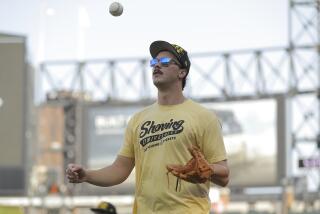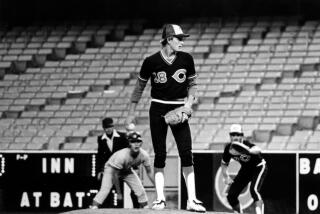The Switch-Pitcher
CHARLESTON, S.C. — Pat Venditte, minor league baseball’s switch-pitcher, hears it all too often.
Fans, friends, even people with his parent club, the New York Yankees, all want to know: “How much longer will they let you pitch with both arms?”
The reliever for the Class-A Charleston RiverDogs smiles for a few knowing seconds, his six-fingered black Mizuno pitcher’s mitt on his knees. “The way I understand it, it’s my job to prove to them that I can’t do it,” he said.
So far, professional baseball’s only righty-lefty reliever has done nothing but improve his chances of eventually becoming the Yankees’ ambidextrous answer out of the bullpen.
Venditte has been lights out the past two seasons at Staten Island and Charleston, converting 36 of 38 save opportunities. This year, he leads the South Atlantic League with 13 saves and has 31 strikeouts -- against one walk -- in 20 innings for the RiverDogs.
Still, Venditte’s two-armed display sounds like one of the goofier notions of Charleston team president Mike Veeck, minor league baseball’s leading showman and the son of legendary baseball promoter Bill Veeck.
“It almost sounds like something Mike would’ve dreamed up if he could,” said RiverDogs General Manager Dave Echols.
The skill, though, is all Venditte.
His father, Pat Sr., encouraged him to throw with both arms and the son never stopped -- 100 tosses with the right arm and 120 with the left. Venditte’s dad had him throw footballs with both arms and write as a left-hander to develop muscle memory. These days, Venditte’s a natural right-hander, “unless I’m stuck behind a tree in golf and have to swing lefty,” he said.
While some youth coaches may have thought it a gimmick, to Venditte, “It’s the only way I’ve pitched since I was 3,” he said, acknowledging it’s a big reason he’s gotten this far.
“I’ve never really had overpowering stuff, so I’m very fortunate I was taught to pitch with both hands because that’s what’s allowed me to pitch in college and eventually here,” he said.
Venditte shows batters two vastly different sides. As a righty, he comes over the top and can hit 90 mph. As a port-sider, he uses more a sidearm delivery and generates more “stuff” with the ball.
Make no mistake, Venditte gets batters out because of his command of pitches -- fastball, slider, changeup from the left; fastball, curveball, changeup from the right -- not his unusual delivery, according to Charleston pitching coach Jeff Ware.
“That’s what makes it really interesting,” Ware said.
Venditte blossomed into a major league prospect -- and national curiosity -- at Creighton. He began as a walk-on and left as a college star, at one point in his junior year going nearly 44 innings without allowing a run.
He figured a career choice was coming very soon.
Venditte was first picked by the Yankees in the 45th round after his junior season in 2007, with the club wanting him to go all righty. But he wasn’t through exploring his potential from both sides of the rubber and returned to Creighton for a final year.
This time, the Yankees took him in the 20th round and told him to keep on throwing righty and lefty.
Venditte has taken some getting used to.
At Staten Island last season, he and an opposing switch-hitter went back and forth to get the most favorable matchup. That quickly led to a “Venditte rule,” where the pitcher must declare which arm he’ll use before the batter stands in. Venditte and the hitter are each permitted one switch after the first pitch is thrown.
“I’ve got to treat him as two different pitchers,” Ware said.
Charleston manager Torre Tyson admitted that over thinking the switch-pitcher matchup led to one of Venditte’s two blown saves. With runners on first and second against Asheville in April, third-year manager Tyson didn’t put on his routine double-steal defense as he got caught up in how best to use Venditte.
The Tourists did steal and two wild throws -- one by the catcher into the outfield, the other by the center fielder trying to catch the winning run at third -- sent Venditte off the mound in disappointment.
Since then, Tyson has grown more comfortable with his unique closer.
“It’s one of those things that makes you think as a coach, a manager, a father, everything,” Tyson said.
Venditte has brought a fun twist to a longtime minor league city famous for such promotions as Vasectomy Night and Nobody Night, where fans were kept outside Riley Park to set a record low for attendance.
These days, the crowd buzz starts when Venditte warms up, first from the right side, then the left.
“I don’t know if you’ve heard of Pat Venditte,” the public address announcer says as the closer takes the mound. “He’s a switch-pitcher.”
Venditte makes quick work of the Lexington Legends in the ninth to save Charleston’s 8-7 victory. He gets his first out as a lefty, then goes right-handed his final three batters, including a strikeout of switch-hitting Federico Hernandez.
Before his next game, Venditte signed autographs for an hour -- right-handed, of course.
“There’s a lot of people who come out here and are amazed to no end,” Tyson said.
Venditte has learned how to handle the attention -- and the skeptics. “It’s not something you see everyday, so people are going to think something’s up,” he said. “It’s my job to get my job done for my team.”
Tyson’s heard from fathers and coaches wondering if they should try this with their young players.
“It seems like a once in a lifetime thing,” Tyson said. “But we could see a ‘Pat Venditte effect.’”
Venditte is not the first professional pitcher to throw with both hands, although he may be the first in the modern era with the potential to regularly switch arms.
Greg A. Harris, who pitched for Cincinnati, Montreal, San Diego, Texas, Philadelphia, Boston and the Yankees from 1981-95, was a righty throughout his career. He pitched from the left side for two batters in the second-to-last game of his career.
The 23-year-old Venditte knows that the Yankees will make the ultimate call in how he’ll pitch.
“That’s OK,” he said. “But if I keep getting guys out, they’re going to let me keep doing it. And getting hitters out is strictly up to me.”
No matter what side of the mound he’s pitching from.


